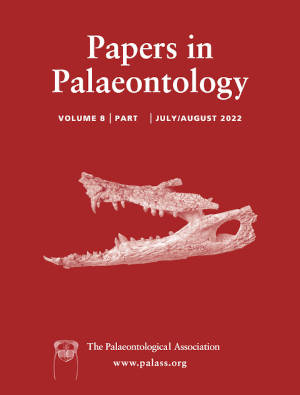Article: Palaeobiogeography of the family Nisusiidae (Cambrian rhynchonelliform brachiopods) using the ‘area-transition count’ method and systematic revision of Korean species
Publication: Papers in Palaeontology
Volume:
8
Part:
1
Publication Date:
2022
Article number:
e1420
Author(s):
Yeongju Oh, Dong-Chan Lee, Sangmin Lee, Seung-Bae Lee, Paul S. Hong, and Jongsun Hong
DOI:
10.1002/spp2.1420
Abstract
Abstract Nisusiidae is a rhynchonelliform brachiopod family that was widely distributed in low-latitude regions during the middle Cambrian (Stage 3 of Series 2 to the Drumian Stage of the Miaolingian Series). Cladistic analysis of 24 nisusiid species including two species from South Korea (Nisusia paucicostellata and Nisusiidae gen. et sp. indet.) demonstrates that the nisusiids consist of two sister clades (Clade 1 and 2) whose common ancestor was derived from a paraphyletic ‘basal’ group. Non-spinose taxa are all included in Clade 1, while spinose Nisusia species are found throughout the three groups including Clade 1, indicating paraphyly of Nisusia. The optimized ancestral area(s) are assigned to internal nodes of the taxon area cladogram using both the Fitch algorithm and the DIVALIKE+J model of BioGeoBEARS, and then the relationship between cladogenetic area transition types and palaeogeographical areas is examined using the ‘area-transition count’ method. Of 10 possible cladogenetic area transitions, which are combinations of range contraction (C), expansion (E), switch (S) and no range change (N), six (CC, CE, CN, EN, NN and NS) are observed in the two optimization results. It is proposed that the nisusiids originated in Laurentia as a strongly spinose form and dispersed into high-latitude peri-Gondwana during Stage 3 and then strongly diversified into other areas during Stage 4, and that non-spinose forms evolved later, mainly in Laurentia. The nisusiid palaeobiogeographical pattern is interpreted to reflect distributional range changes that were probably caused by palaeo-oceanic currents with the aid of island arcs as stepping stones, and pumice, produced by volcanic activity, as the means of dispersal.
